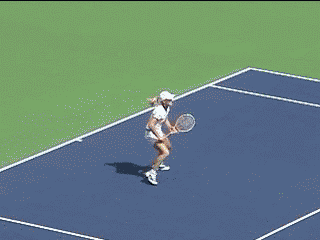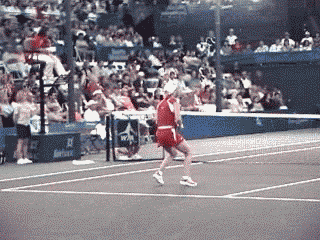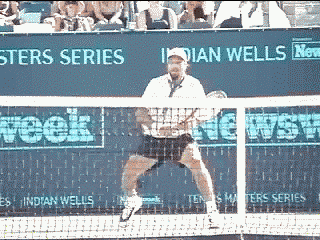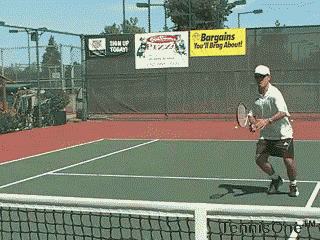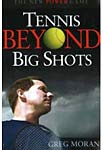| TennisOne Lessons Quick Tips for Tennisís Four Toughest Shots Greg Moran There are four shots in the game that strike fear into the hearts of the recreational tennis player. Though they’re awkward to execute, with a few tips and a “just get it back” approach you’ll be able to handle them and often surprise your opponents by returning a shot they thought they’d hit for a winner. The Half-Volley A half-volley, or pick-up, is that annoying shot you have to play when a ball bounces right at your feet. You can’t move forward fast enough to hit it out of the air, and it bounces too close to you to hit a proper groundstroke. It’s literally half a volley and half a groundstroke.
Usually we get caught having to play a half-volley when we approach the net and our opponent drops the ball at our feet. Sometimes, however, we have to hit a half-volley when we’re standing inside our own baseline and our opponent hits a deep groundstroke right at us. Your goal when hitting the half-volley is to just get the ball back in play. Use an extremely short backswing or no backswing at all, keep a firm wrist, and bend at the knees and lower yourself to the level of the ball. Your racquet should be out in front of you. A good exercise to practice the half-volley is to say the words “boom boom” to yourself as fast as you can when hitting the shot. This will give you a feel for the rhythm involved and will improve your timing. Don’t try to hit a winner off a half-volley, just get it back and then move into the net for you next shot or back behind the baseline so you won’t have to hit another one.
The Backhand Overhead Former World # 1, Kim Clijsters, makes this shot look easy but for most of us, the backhand overhead can be the toughest shot in the game. It’s another of those "just get it back" shots so don’t try to do anything fancy or aggressive with it. Just put the ball back in play and go from there. When your opponent lofts a short lob over your backhand shoulder, if you react quickly enough, many times you can run around it and hit your regular overhead. However, if you must play the ball on your backhand side, I suggest turning the shot into a volley. Immediately turn your body, use a short backswing and just strive to make solid contact. Punch it back deep and get into position for your next shot. Right at You
How often have you been at the net and your opponent blasts the ball right at you? This happens quite frequently, particularly in doubles, and is in fact an excellent strategy that often handcuffs the net player. So, how do you avoid that “deer in the headlights syndrome” when you’re an easy target for your opponents body shot? Ideally, when a ball is coming right at your body, try to move to one side and play either a comfortable forehand or backhand volley. Often, however, you don’t have the time to move. In that case, keep your wrist firm and play a backhand volley. That’s really the only way you can physically get the racquet in front of your body without severely (and dangerously) contorting your arm. Keep your wrist firm and just let the ball hit the strings. The Backfire or Over the Shoulder Shot A topspin lob goes over your head and you know right away you’re in trouble. You can’t take the ball in the air, and getting behind it to hit a controlled stroke is just not in the cards. You’re going to have to hit the shot in front of your body with your back to the net. Now what?
llie Nastase, one of the most talented players ever to grip a racquet, made famous a shot he called the Bucharest Backfire for just this situation. Line yourself up so that when the ball bounces, it’s over your left shoulder (if you are righthanded; for lefties, it’s the opposite shoulder). Then swing your arm and flick your wrist up into the ball over your left shoulder. A continental grip is the best for this shot as it gives you a bit more flexibility in your wrist. You can hit any kind of shot with a backfire, from a high defensive lob to a low offensive drive that just clears the net. It all depends on how athletic and aggressive you want to be on the court. For most of us, however, the goal here is just to get the ball back with a high lob and stay in the point. Though these four shots may never be your biggest weapons but they don’t need to be major weaknesses. By using simple technique and a just get it back approach, you can return these difficult balls and stay alive while you wait for your opportunity to take control of the point. Your comments are welcome. Let us know what you think about Greg Moran's article by emailing us here at TennisOne.
Tennis Beyond Big Shots presents a bold back-to-the-future approach. A new game that moves away from power and big shots yet is more lethal to opponents than any booming serve. Greg Moran shows players of all ages and abilities that, with simple and small changes, you can not only maximize your tennis wins and play longer, but also have much more fun doing it. Click link to purchase Greg Moran's book, Tennis Beyond Big Shots. Mansion Grove House is pleased to announce that in May, 2008, they will release the second edition of Tennis Beyond Big Shots. Written by Greg Moran, the book (which includes a new chapter) was Amazon's #1 new tennis release in 2007. |
